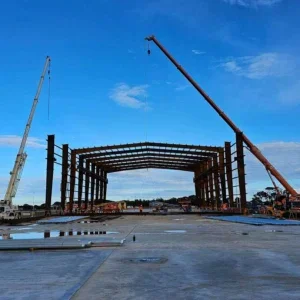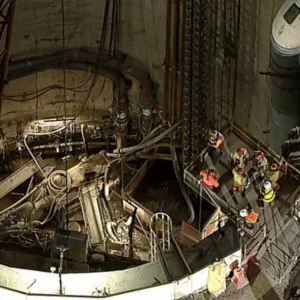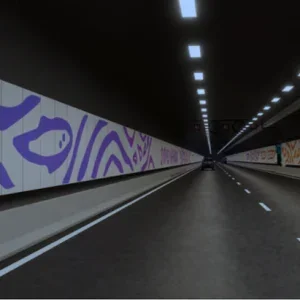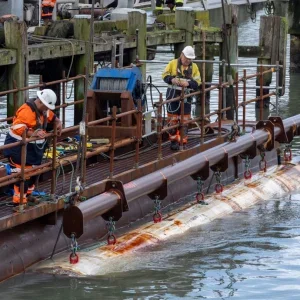Dear Sir
I have read with great interest the article by Dr. Bezuijen, “Bentonite and grout flow around a TBM” published in the June 2007 issue of T&TI, p39-42. The topic is definitely one of the most important in the field of mechanised tunnelling, being the management of the void around the shield of a TBM as one of the major sources of concern for both designers and contractors involved in urban tunnelling projects.
To study the behaviour of the ground, the grout and the bentonite slurry surrounding the shield of a TBM one needs to understand: (1) if we have to expect any volume loss due to the conical shape of the shield, (2) if we are able to calculate it accurately, and (3) if we can mitigate it. These are, incidentally, the key elements of the modern approach to tunnelling based a Risk Management Plan: i.e. to identify, evaluate and mitigate the risks.
A key conclusion of the article is: “One dimensional calculations showed that it is very likely that the tail (void) of the TBM is to a large extent supported with bentonite and grout and not with soil. Therefore there is no direct relation between the tapering of the TBM and the volume loss, as is sometimes suggested” (page 42, 3rd column). This conclusion is both exciting, and at the same time disturbing, to the extent that the following series of questions sprang straight to mind almost immediately:
Firstly, are we sure that with the results from a simplified 1-D model and a few example calculations one can come so quickly to such a revolutionary statement?
Secondly, how much evidence collected in the field can be used to support this theory?
Thirdly, supposing that the theories advocated in the article could be accepted, would it be correct that the real conclusion should be as stated in the article? Or, at least, should we change it to something like “…Therefore, the potential volume loss due to the tapered shape of the shield of a TBM can be recognised and reduced by acting on the tail-void-grouting pressure, with the desired maximum pressure determined by rigorous calculations and calibrated carefully in the learning-curve period using feedback from an appropriate monitoring system, etc., etc.?”
Please allow me to continue with some other doubts in detail.
In the article, the first example calculation of the grout pressure distribution along the shield does not consider either the presence of bentonite slurry or the pressure in the plenum.
Thus, how is it possible that the grout pressure, after a (natural) decrease, can increase again along the shield from the tail to the cutterhead?
What is the physical explanation for this phenomenon?
In reality, in the first stretch of the shield (close to the tail), the calculated pressure is the grout pressure, and in the second, it is the ground pressure.
As a matter of fact, according to the same example, at a certain point of the shield, 2.2m from the tail in Figure 2 – symmetric situation, and 3.5m from the tail in Figure 3 – asymmetric situation (these need to be confirmed because the figure captions and legends are not very clear, or maybe even wrong), the gap between the ground and the shield drops to zero, i.e., the ground is now in contact with the shield and there is no more grout around this part of the shield.
In effect, on page 40, in the third column, reference is made to the “soil pressure” which should be, at the location of contact between ground and shield, “100kPa less than the original value”.
Consequently, I have to suppose that the original value of “soil pressure” is shown in Figures 2 and 3 as of “zero” value (but there is no mention of soil pressure in these figures). And, if my interpretation is correct, it would mean that the grout injection pressure would not be 500kPa, as given in Table 1, but 500kPa higher than the soil pressure at this location.
Clearly, further explanations of these points are needed from the author to help readers properly understand the problem. Furthermore, in my opinion, it is necessary to also calculate the forces acting on the shield body as a consequence of the applied pressures (from both the grout and the ground) around the shield, because the deformation of the shield cylinder itself is another key factor to be considered.
In the second example, face-support pressure and bentonite slurry were introduced and three scenarios were analyses (see Figure 4).
Scenario 1: both the grout and the slurry are moving: one from the tail forward, while the other moves from the cutterhead backward and they will meet somewhere along the shield.
Scenario 2: the bentonite slurry and the grout flow in the same direction from the cutterhead to the tail.
Scenario 3: contrary to the case of Scenario 2 the grout and the slurry flow from the tail to the cutterhead.
The example continues with the representation and relevant calculations for Scenario 3 only, showing the pressure values of both the Bingham liquids present around the shield and the corresponding annular-gap width.
In accordance with the assumption that in Scenario 3 the grout and the slurry are moving in a back to front direction, the corresponding pressure values should be decreasing from the back to the front of the shield. The figures 5 to 7 in the article are supposed to show the corresponding trends (please note that Figure 6 shows twice the same pressure graph and the gap-width graph is missing). However, I wonder why the bentonite slurry pressure is shown to increase, instead of decrease, moving away from the pressure source (i.e., the plenum at the front)?
Attention should also to be paid to the pressure values in the examples: the grouting pressure is 1.6 to 1.8 times bigger than the face-support pressure. These are extremely high values that could cause serious problems to the tail brushes (at least in my experience).
The conclusion of this example is that, depending on the shield diameter and length, the initial width of the annular gap around the shield, and the initial values of the grout pressure and the bentonite-slurry pressure, the two fluids come into contact somewhere along the shield. If the initial pressure values are high enough, the annular gap width is always bigger than the original one, so the ground is pushed away from the shield.
But looking at the example shown in Figure 6, with 90% of the shield length covered by cement-based grout, I have to ask the following questions:
What could happen if the TBM should stop for 3 or 4 days for any reason?
Could it re-start easily? Or, would the hardened mortar block it?
My doubt is that, in reality, there is only one probable and credible scenario, the first one. The two pressure gradients always tend to decrease from the extremity towards the centre of the shield. Depending on the initial-pressure values of the grout and bentonite slurry the “meeting point” of the two heavy fluids moves along the shield and if the difference between the two initial values was high enough, the fluid with the higher pressure can “push back” the other one.
The above mechanism is well known by those who have used a slurry shield: how many times has it been observed that bentonite slurry flows into the tunnel by passing through the tail sealing system!
On the contrary, sometimes, but not very frequently, traces of grouting mortar can be found in the muck, proving the fact that the grout can enter into the plenum.
Well, arriving at this point I still have the same problems and the same concerns as those I had before reading the article by Dr. Bezuijen, so I remain one of those who “sometimes suggest that there is a direct relationship between the tapering of the TBM and the volume loss”.
Nevertheless, I totally agree with the last sentence in the conclusions of the article: “The model shows that a good pressure control is essential when tunnelling in soft soil”.
This is because I have been recommending to people to control the pressure and volume of grouting continuously during each excavation cycle and during segments erection, advising at the same time that one should watch that the grout does not travel too far away from the shield tail to avoid the risk of finding the shield stuck.
Vittorio Guglielmetti
Independent Consultant,Italy







